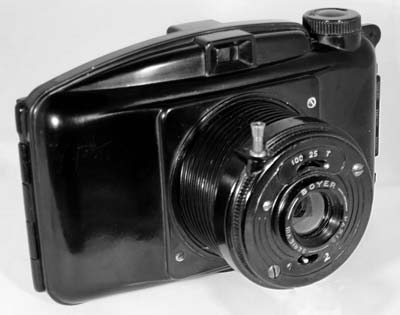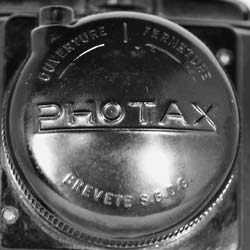MIOM Photax III
Specification

| Manufacturer | : | M.I.O.M. |
|---|---|---|
| Produced | : | 1947 |
| Classification | : | Medium Format |
| Body Type | : | Extending Helicoid |
| Construction | : | Bakelite |
| Film Type | : | 620 |
| Film Width | : | 62mm |
| ImageSize | : | 2¼ x 3¼ |
| No. of Images | : | 8 |
| Lens Type | : | Boyer Series III |
| Focus Type | : | Fixed |
| Focal Length | : | 82mm |
| Focal Range | : | 2.75m - inf. |
| Aperture Type | : | Multihole |
| Aperture | : | f/14, f/22 |
| Shutter Type | : | Guillotine type |
| Shutter Speeds | : | T, 1/25, 1/100 sec |
| Size Open (w x h x d) | : | 155 x 95 x 93 mm |
| Size Closed (w x h x d) | : | 155 x 95 x 65 mm |
| Weight | : | 375g |
Art Deco Credentials
![]()
![]()
![]()
Noteworthy: Worth giving special attention
- Body shape designed in the main Art Deco period.
- Polished Bakelite
- Curvilinear body design
- Concentric raised circle markings on lens plate
- Ribbed and stepped viewfinder moulding
Description

The Photax is a viewfinder camera made almost entirely of Bakelite. It took 6x9cm exposures on roll film. Six different models were introduced between 1937 and 1960. The Photax III body shape is identical to the Photax II model which came out in 1938. So this camera truly has Art Deco credentials. The photax II has only two speeds - T & I. The cameras were also available with a lens cover known as the blindé variant. The cover also protected the shutter release. The shape of this camera was copied by several manufacturers, notably by the Gevaert for its Rex Lujo.
The camera is fairly simple. On the top is the optical viewfinder and the film advance wheel. On the bottom is the tripod mount. On the back is the red exposure counting window. All other functional parts are on the lens barrel's front plate. The camera's most characteristic feature is that the lens is deployed by turning the barrel counter-clockwise by about 300 degrees. The helicoid screw moves the lens outward into the working position. The functional elements on the lens tube's front plate are the meniscus lens, a two position switch to change the aperture and a switch to select one of the shutter speeds. The shutter has a tall release button which travels sufficiently to cock the shutter before exposure.
How to Use
This camera takes 620 film which is still available from selected photographic outlets. Although the actual film is the same as 120 film, the spools are different. The 620 spools are slightly shorter and have a smaller diameter. Do not use 120 film in this camera because it will jam and may snap. It is possible to cut down a spool of 120 film to fit or to re-spool some 120 film onto 620 spools in a darkroom or changing bag. Don't forget to cover the red window with black electrical tape except when advancing the film in low light. Modern film is sensitive to red light.
Shutter speeds are 1/25s and 1/100s. The aperture values available are f/14 - f/22.
If you don't want to bother with an exposure meter, follow the guide shown. It is based on the 'Sunny 16' rule. Film is so forgiving and will produce acceptable results even when overexposed by 2 or 3 stops or underexposed by 1 stop.
Remember that the exposure guide in the camera user manual may not be helpful as it is based on the use of old film with a low ISO value.
The tables assume that the sun is at least 30 degrees above the horizon - that's 10am - 5pm on a summer's day (May-August) in the UK.
If you are not sure about the light level, err on the side of overexposure - i.e. assume the smaller f number.
Where there is a choice, a larger f number will give a larger depth of field.
For the slower speeds, you may need a tripod to stop blur through shake.
Using ISO 100/125
Key: Green - Good exposure; Amber - acceptable exposure; Red - unacceptable exposure. Number of stops over or under shown.
| Weather Conditions | Shadow Detail | Shutter Speed (s) | |
|---|---|---|---|
| 1/25 | 1/100 | ||
 Sunny SunnySnow/Sand | Dark with sharp edges | f/22 +2 over | f/22 |
 Sunny Sunny | Distinct | f/22 +1 over | f/14 |
 Slight Overcast Slight Overcast | Soft around edges | f/14 +1 over | f/14 -1 under |
 Overcast Overcast | Barely visible | f/14 | f/14 -2 under |
 Heavy Overcast Heavy Overcast | None | f/14 -1 under | f/14 -3 under |
 Open Shade Open Shade/Sunset | None | f/14 -2 under | f/14 -4 under |